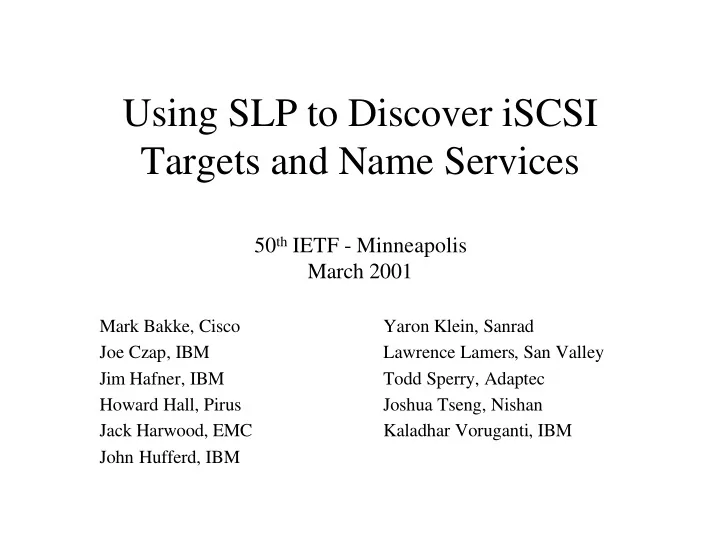

Using SLP to Discover iSCSI Targets and Name Services 50 th IETF - Minneapolis March 2001 Mark Bakke, Cisco Yaron Klein, Sanrad Joe Czap, IBM Lawrence Lamers, San Valley Jim Hafner, IBM Todd Sperry, Adaptec Howard Hall, Pirus Joshua Tseng, Nishan Jack Harwood, EMC Kaladhar Voruganti, IBM John Hufferd, IBM
Status • Background – Needed discovery protocol that could multicast – Suggestion to consider existing discovery protocols • Key Decisions – SLP discovers targets in a local environment – SLP discovers name services in a larger environment • Milestones – Draft 00 of SLP Template submitted
Basic Discovery Requirements • Find targets by initiator’s WWUI – “Tell me which targets you have that I should see” • Find targets by target’s WWUI – “Where is target iscsi.com.acme.foo?” • Propagate attributes needed before connecting – Boot information, authentication information • Scaling requirements – Zero-configuration, no servers in small environments – Reduce or eliminate multicast in medium environments – Interoperate with LDAP/iSNS in large environments
Discovery Approach (NDT) Deploy and interoperate in three stages: 1. Naming and Static Configuration – Configure both targets and initiators – Use SendTargets to reduce initiator config 2. SLP for multicast and simple discovery – Configure targets 3. iSNS for centralized management – Configure central iSNS server
Service Location Protocol 101 • Service Agent (SA) host Management Code – Advertises services – Services have attributes SLP iSCSI Initiator UA • User Agent (UA) TCP/IP – Finds services SLP – Zero configuration IP DA • Directory Agent (DA) TCP/IP – Optional SLP iSCSI – Propagate service adverts Target SA • SLP Protocol Management Code – UDP or TCP device – Minimize multicast
Implementing SLP for iSCSI • Targets implement a Service Agent – Answer multicast requests or register with DA • Initiators implement a User Agent – Use multicast or DA to locate targets • Devices containing targets register: – The canonical target or individual targets – Attributes of targets • Register target at each of its addresses
iSCSI SLP Template • iSCSI Service URL – service:iscsi:target:10.1.1.1:500/<target-wwui> • Attributes for service:iscsi:wwui – WWUI – WWUI of target – Alias – Access-wwui – list of initiators allowed access – Boot-wwui – initiators that can boot from target – Roles, transports, mgmt-ipaddr, entity
SLP and iSNS • SLP used for target discovery – No configuration required for the simplest networks – Small footprint; no servers required – Just enough discovery for small-to-medium networks – Device-centric access control model • iSNS adds storage management capabilities – Active monitoring of initiators and targets – Event propagation – Public key distribution – Centralized access control model
Using Both SLP and iSNS • Initiators can use both SLP and iSNS to discover targets • Targets should use SLP only if not configured for iSNS • Gateways or proxies may provide local SLP discovery of remote iSNS devices
SLP Summary • Serverless discovery of targets – Optional, generic DA to scale services • Zero-configuration of hosts – SLP makes careful use of multicast • Access list & attribute propagation • Optional message authentication • Available open source implementations
Other Discovery Mechanisms • DNS SRV – too limiting • LDAP – Just a database interface – SLP can easily work with LDAP • Jini – Requires Java; company-controlled • UPnP –XML/HTTP; company-controlled • Salutation – API; has interface to SLP • Bluetooth, HAVi – not-IP environments
Current Work Items • Interoperability with iSNS – Should SLP refer an initiator to iSNS? – Can they share some code (authentication) • Host/Device taxonomy & recommendations – What should implement SLP, iSNS, or both? • See how open source implementations help – Completeness – Authentication
Issues • Should initiators be registered? – Not needed for simple discovery – Would be needed to distribute certificates • Implementation – Authenticated SLP – SLP event propagation still being defined – mSLP – using multiple DAs
Plan • March – Accept SLP draft as a WG document • May – Incorporate comments on draft – Re-issue draft as a WG document • August – Final draft at IETF-51
References • Service Location Protocol, version 2 – RFCs 2608, 2609 • SLP document – Draft-bakke-iscsi-slp-00 • iSCSI NDT Requirements – Draft-ietf-ips-iscsi-name-disc-00 • iSNS document – Draft-ietf-ips-isns-01
Recommend
More recommend